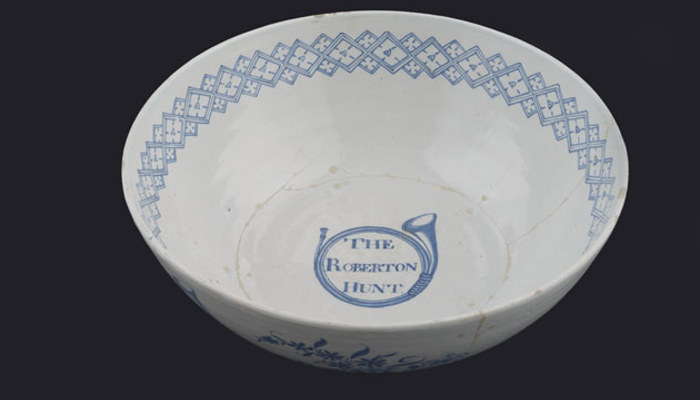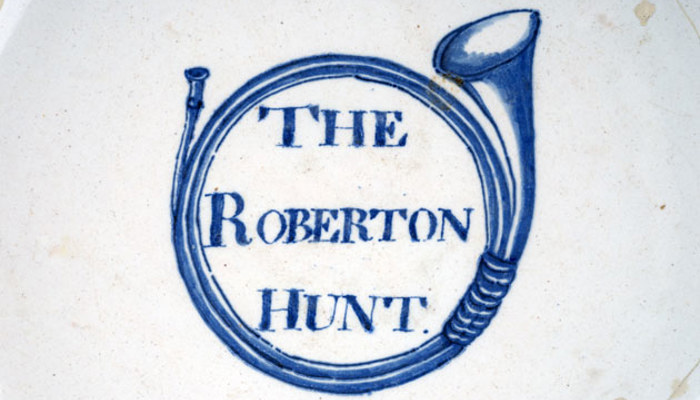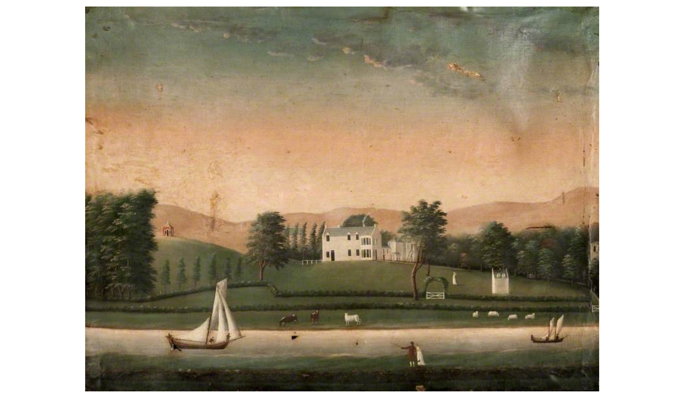
Drinking the fruits of enslaved labour

The Roberton Hunt punch bowl
PP.2003.11
Images © CSG CIC Glasgow Museums Collection
5th June 2019
This ceramic bowl is known as ‘The Roberton Hunt’ bowl. It belonged to the members of an 18th-century fox hunt which took place twice a year in Renfrewshire and Lanarkshire.
In 1771, the year the hunt was established, the club’s treasurer ordered four of these bespoke delftware bowls, customised with the club’s name. They were designed to be the right size for punch made from one bottle of rum. He also ordered some nice uniforms for the members to wear and made arrangements for dinner. Finally, he ordered in a hogshead of London porter, 72 bottles of strong beer, 60 bottles of port wine, 12 bottles of sherry and eight gallons of French brandy, to get things going. While the official purpose of the club was to engage in blood sport, drinking, dining and socialising seem to have been the overriding rationale for its meetings.
This bowl – the last one known to survive of the original four – was used to serve rum punch to the hunting club’s members. The drink was poured into individual glasses using a ladle. Rum punch was an incredibly popular drink made from several of the exotic products that flowed into Glasgow at this time, thanks to its lucrative colonial trade: sugar, limes, lemons and rum from West Indian plantations – the fruits of enslaved labour, quite literally.
Embedded in the bowl is a fascinating story about the pursuits and lifestyles of Glasgow’s wealthiest, and ultimately, how these were made possible by business ventures that depended directly on the labour of enslaved people.
Images



The Roberton Hunt attracted young and promising men, many of them in their mid-to-late 20s at the time the club was founded. Of the 23 founder members most were sons of established merchant families within Glasgow’s tight-knit social and commercial elite. Often they were related to one another by kin, marriage and business partnerships. They included landowners; tobacco, sugar and cotton merchants; owners of enslaved people; and industrialists.
Brothers John and Matthew Orr were among the core group behind the Hunt. They owned estates at Barrowfield and Stobcross, operated a coal mining business and owned plantations in the Caribbean island of Tobago. Cousins James and James Dunlop and their peers Andrew Houston, Robert Dreghorn and Robert Dunmore were sons of wealthy tobacco and sugar merchants. They worked in the family businesses, were partners in numerous industrial ventures and owned estates in Scotland and the Caribbean. The Dunlops’ brother-in-law, tobacco merchant Thomas Donald, also the son of a tobacco merchant and in business with his uncle, the Lord Provost of Glasgow, was also a member of the hunting club.
For these young men, taking part in fox hunting, and the drinking and dining that were part and parcel of club membership, was a way for them to display they belonged in the city’s social and commercial elite. This elite lifestyle was funded directly from their trade in goods produced by enslaved labour.
Katinka Stentoft Dalglish,
Curator of Archaeology
